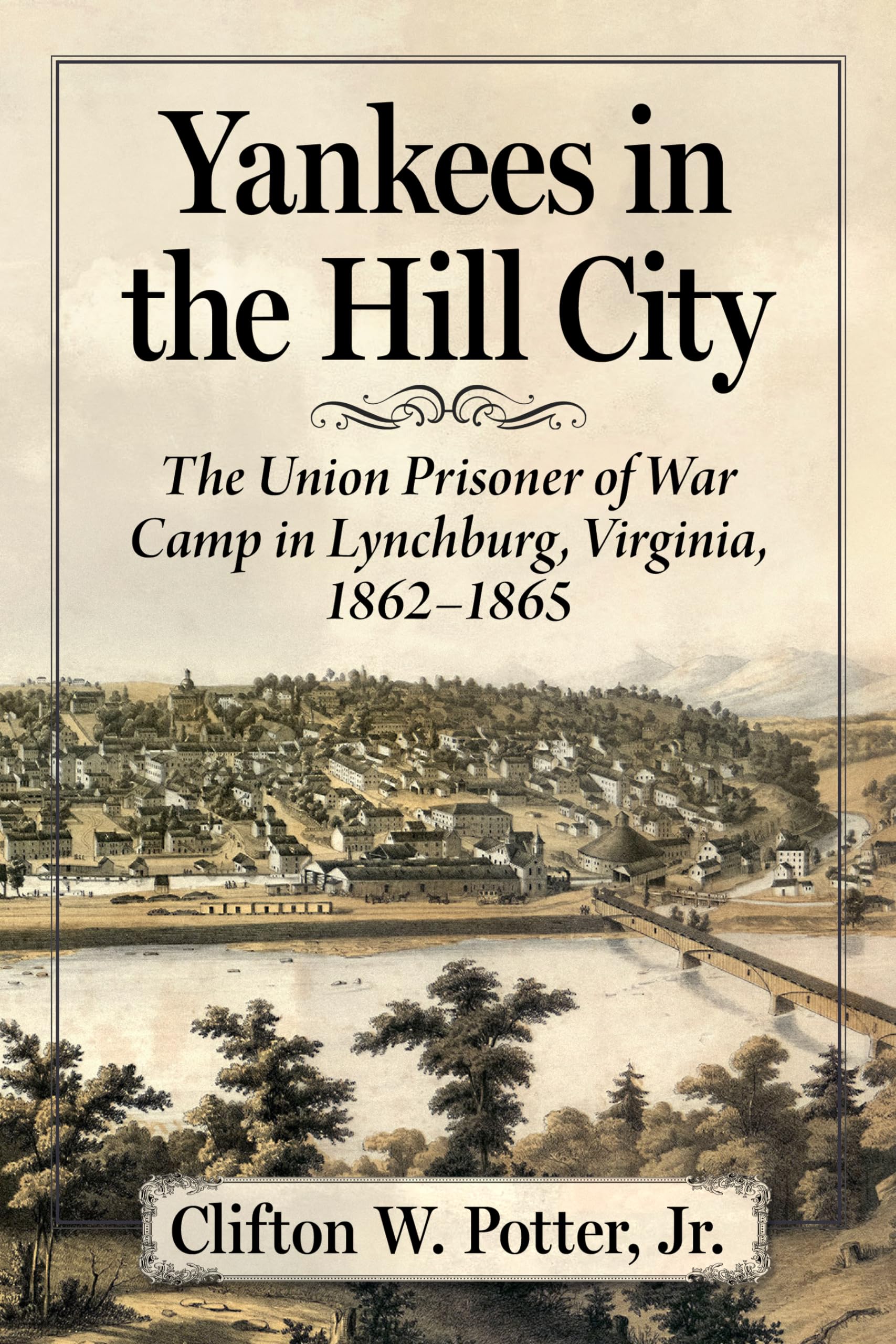Book Review: Yankees in the Hill City: The Union Prisoner of War Camp in Lynchburg, Virginia, 1862-1865
Yankees in the Hill City: The Union Prisoner of War Camp in Lynchburg, Virginia, 1862-1865. By Clifton W. Potter, Jr. Jefferson, NC: McFarland & Company, 2024. Soft cover, 224 pp. $39.95.
Review by Patrick A. Schroeder
In the grand scheme of the Confederacy’s prisoner of war camps, Lynchburg may be overlooked among the familiar names such as: Libby, Belle Isle, Salisbury, Florence, Danville, and Andersonville. Lynchburg played a part in that system, though more as a temporary holding site before moving prisoners to more permanent locations.
Author Clifton Potter, Jr. writes extensively about Civil War Lynchburg, and his expertise is apparent, even outside the prison aspect. Despite the book’s title, only two chapters fully focus on Lynchburg’s war-time prisons, while the remaining four chapters are a catch-all for Civil War Lynchburg, including a history of Lynchburg from founding to the war, the town’s Confederate hospital system, and the 1864 Battle of Lynchburg.
Potter reveals that the first use of Lynchburg as a prison holding area dates to mid-November 1861, when Union prisoners arrived after their capture at Guyandotte in western Virginia (now West Virginia) on the Ohio River. Lynchburg was a natural location for holding prisoners as it was connected to three railroad lines and the James River Canal.
In June of 1862, Confederates established an open air prisoner of war camp in the Fair Grounds (now the site of E. C. Glass High School) with a dead line perimeter rather than a formal stockade wall enclosure. Though officials expected the camp to hold up to 500 prisoners, at times it contained as many as 3,000, though it did not stay that way for long as it was a temporary camp. Colonel George Gibbs, who set up the prison camp at Salisbury, North Carolina, was sent to Lynchburg to do the same. Initially the 21st Virginia Infantry guarded the camps, but the 42nd North Carolina Infantry replaced them during Stonewall Jackson’s Valley Campaign, when 2,800 fresh prisoners arrived at the camp.
Being a transitory camp, primary sources referring to it do not exist in great quantity, but Potter did locate several to anchor the story of the Lynchburg prison. These include the diaries of Private Charles Blinn of the 1st Vermont Cavalry and Ziba Roberts of the 28th New York Infantry.
Aside from the prison camp, Potter points out that Lynchburg had the second largest hospital system in the Confederacy, thus the Union prisoners often received better medical attention while in Lynchburg than at most other holding facilities. Lynchburg hospitals achieved a good survival rate. Those prisoners who did die were collected in a wagon by the firm of George A. Duiguid, taken to City Cemetery, and buried in “Yankee Mound.” Duiguid kept thorough notes, recording the names and burial information. His namesake funeral service remains in business today in the Hill City.
In Chapter 5, Potter provides a very good overview of the 1864 Battle of Lynchburg. In that action, Union General David Hunter really never got close enough to liberate the camp’s prisoners, and it remained in use until the end of the war. The Union prisoners finally receive their freedom when Federal troopers under General Ranald Mackenzie reached Lynchburg following Lee’s surrender at Appomattox. All liberated Union prisoners that were ambulatory were sent to Camp Parole in Annapolis, Maryland. Potter continues Lynchurg’s story into the post-war years by covering the city’s Union occupation expereince, which includes scandal, incidents, and events of that period to when Federal troops left in 1870, and even beyond.
The book also includes two informative appendices. The first is the “Burial Records for POW’s 1862-1865,” which is interesting to scan to see some of the units that had POWs held at Lynchburg. The other is a list of Union casualties in the Lynchburg Campaign. These do not relate to the prison camp, but do tie into Chapter 5 and the Battle of Lynchburg. The book should have included a map showing where the prison camp, hospitals, and cemetery where all located. This would have tied everything together nicely for readers.
Potter collected the research materials for the book over decades, and in the end, there is just not that much out there. However, what he does present fills a void that once existed when studying the Confederate prisoner of war system. With the relatively sparse availability of information on the prison and the soldiers held there, the book might be more aptly titled “The Union Experience at Civil War Lynchburg, featuring the Union Prisoner of War Camp.” Even so, Yankees in the Hill City is certainly worth the read and critical to understanding war-time Lynchburg.
Civil War author/historian Patrick A. Schroeder is the full-time Historian at Appomattox Court House National Historical Park. He graduated cum laude with a B.S. in Historical Park Administration from Shepherd College, in Shepherdstown, West Virginia, and has an M.A. in Civil War History from Virginia Tech. He has written several books on various Civil War topics including Thirty Myths about Lee’s Surrender. In addition, Patrick has studied Civil War Zouaves extensively over the last four-plus decades as a living historian and he has written, edited, or published a half dozen books related to Zouave regiments and soldiers, including “We Came to Fight: The History of the 5th New York Veteran Volunteer Infantry, Duryee’s Zouaves, 1863 to 1865,” and Brian Pohanka’s “Vortex of Hell” about the original 5th NewYork Zouave 1861 to 1863. Patrick lives in Lynchburg, Virginia.

